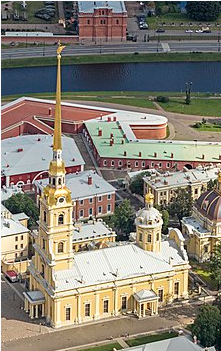
The Peter and Paul Cathedral in the Peter and Paul Fortress, St. Petersburg. The Cathedral houses the remains of all the Russian tsars and tsarinas from Peter I to Nicholas II (whose remains were delivered in 1998), minus Peter II and Ivan VI. Credit Wikipedia.

Statue of Peter the Great at the Peter and Paul Fortress, St. Petersburg. This statue is supposed to more accurately reflect what Peter the Great may have actually looked like. Credit Ian Fries.
Opening the Peterhof museum video, there is a sweeping shot over two huge ponds in the center, flanked by hedge gardens. The round pond in the foreground is filled with large golden fish fountains. Cut to the second rectangular pond which has a large stone statue of Neptune, holding a trident and surrounded by men on sea horses at the base of the statue. Then there is a brief shot of the white palace roof, showing a large gilded spire. The walls of the palace are painted yellow with white columns and windows. In front of the palace is a step fountain with black and white tiles and gold statues, then a pond with a fountain shooting water vertically into the air, and finally a long canal leading to the sea. The statue in the center of the fountain is a man opening a lion’s mouth, eight jets of water shooting out around them and a ninth jet shooting from the lion. The gardens have a pair of two-tiered fountains that have gilded laurels on red granite tiles on the central pillar. Another fountain has water spilling down a black and white checkerboard onto a natural rock face. A third fountain has multiple small jets shooting up around an uncompleted rectangle supported by Greco-Roman style columns. A fourth fountain features a gold statue of a man wrestling a dragon.
The video continues on, but I feel the point is made: most of this iconography and architecture, is, obviously, not Russian. The style of the statues themselves, is neoclassical. This palace would not be out of place anywhere in 18th century Western Europe, and is highly reminiscent of Versailles or the later-built portions of Hampton Court.
However, there are also two buildings on the flanks of the main palace with gilded onion domes similar to an Orthodox church. This is a strictly non-Western piece of architectural design, and it makes me wonder why Peter would include it, because another piece of Petrine architecture, the Peter and Paul Cathedral (constructed between 1712 and 1733), does not feature onion domes. Which prompts the question: why does the palace of Peter the Great feature onion domes and not the cathedral he similarly dedicated?
How does the palace reflect more of Peter’s revolutionary desires to emulate western European culture and how is still a reflection of older Russian traditions? How does the palace reflect Peter’s revolutionary goals more generally?

While onion domes are not element of Western architecture, it was an element of Russian architecture that Russia could be proud of. The Cracraft reading tells of several Western visitors to Moscow, including John Perry, and Adam Olearius, who admired the cities churches, monasteries, mansions, steeples, copulas, and almost certainly the city’s onion domes. Of course, these visistors later go on to comment that all this splendor only serve as as facade for a city that was medieval in layout and architecture.
Including the onion domes may have helped Peter’s westernization effort by defining the newly imported architectural style as a union of Western and Russian elements, rather than an imposition of entirely Western forms on Russia.
I can’t remember exactly from which country/culture the onion dome tradition was taken (I think generally the Middle East/India?), but they are hugely reminiscent of the churches in Moscow. Moscow used to have the most churches per capita of any other European city, a testament to its piety perhaps? I imagine that these domes, come to be viewed as a distinctly Russian style of architecture in combination with more European style buildings, is a nod by Peter to Russia’s heritage. It’s conceivable that he included these domes as a sign that though modernization was coming from the west, Russia was still Russia and that it need not lose all its innate Russianness in making itself more European.
The main thing that I find lacking as compared to the Red Square in Moscow is the lack of Muscovite influence. The bright red facade and ornamental Muscovite trappings of the buildings are ornamental and reflect a traditional design as compared to the Peterhof. Even the church built in an older style on the ground is respectfully designed and does not have the garish aesthetic of Red Square.
This really reminds me of France and the palace of Versailles. Here, we have Peter building palaces and churches to show that he has power to the rest of the world and that he too, can “control” nature as we had seen in the pictures of his palaces greenery and water fountains that seemed to defy the laws of science.